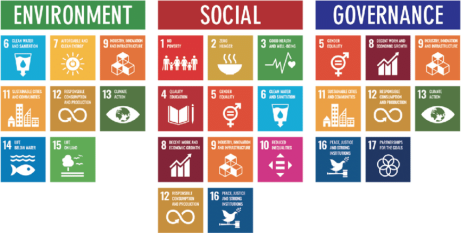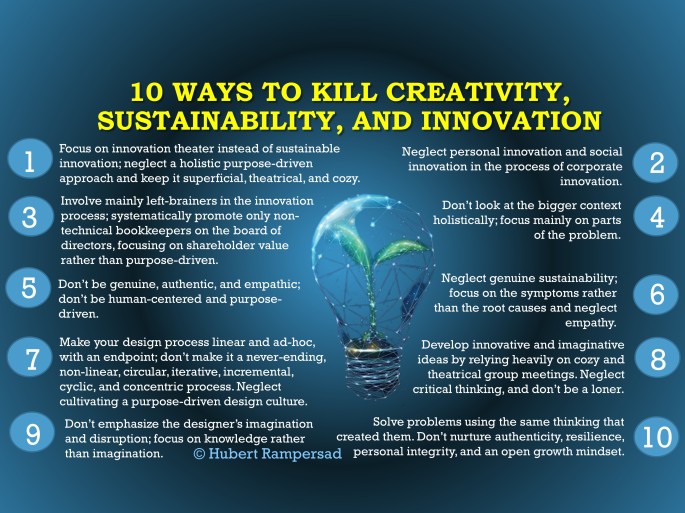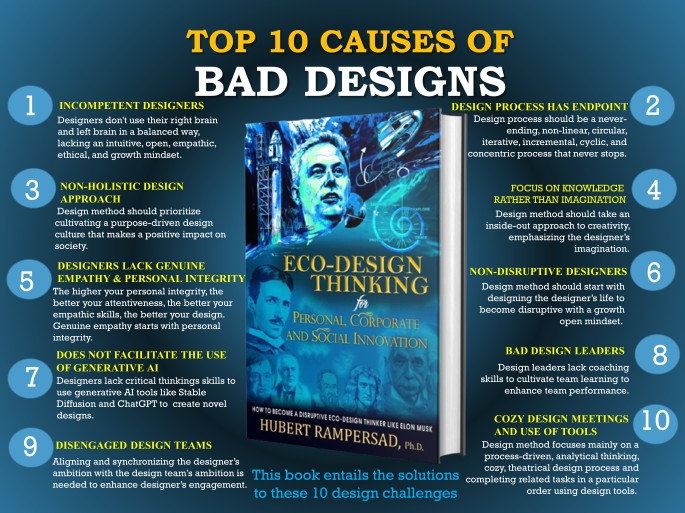“The approach to addressing climate change is wrong as it only focuses on the symptoms rather than the root causes. Educating individuals on the significance of personal integrity and how our actions impact the environment, including all living beings, is vital. Empathy is crucial in establishing a strong foundation for environmental consciousness, which starts with personal integrity. To combat climate change effectively, we need good people. Still, unfortunately, the world is full of bad people, which may explain why only a few individuals are actively involved in the fight against climate change”.—Hubert Rampersad.
Hubert Rampersad, Ph.D.
Within organizations, the narrow-mindedness of leaders, project managers, and designers often leads to a lack of creativity, sustainability, and innovation. Unfortunately, many companies’ boards of directors may not truly understand the importance of genuine sustainability and sustainable innovation, resulting in missed opportunities to create a better world. While the Environmental, Social, and Governance (ESG) framework has been in place since the 1970s, and the Sustainable Development Goals (SDGs) were established by the United Nations General Assembly in 2015, neither is comprehensive enough. The SDGs focus on 17 critical areas to address economic, social, and environmental challenges by 2030, while the ESG framework emphasizes environmental, social, and governance factors. However, the SDG framework isn’t sustainable because true sustainability begins with good people; unfortunately, the world is a whole of bad people. All 17 SDGs cannot be achieved sustainably without creating good people first, and it’s shortsighted of the UN to overlook this crucial aspect.
Most important, SDG #18 is missing!
“It is important to acknowledge that the Sustainable Development Goals (SDGs) do not include the essential SDG #18: GOOD PEOPLE. To truly address the root causes of climate change, we must move beyond simply treating its symptoms. We must focus on nurturing personal integrity, including mindful of how our actions and behaviors impact all living beings – humans, animals, and plants. This is the foundation of empathy, crucial for effective action against climate change. Regrettably, the world is full of bad people who don’t prioritize these values, which is why so few are engaged in efforts to combat climate change”. – Hubert Rampersad. Why is this significant shortcoming not addressed by the bureaucratic United Nations?

SDGs, ESG, and Purpose
The SDG and ESG frameworks share a common principle of promoting sustainability. Their primary aim is to positively impact the world and achieve a greater purpose. However, it’s crucial to recognize that this purpose must not be a fleeting trend but a sustainable approach. “Sustainability involves a holistic and ethical approach that aims to establish a harmonious coexistence between humans and nature for an extended period.”—Hubert Rampersad.
Understanding an organization’s purpose is essential to knowing its values and positive impact on its employees, society, and the environment. The roots of an organization’s purpose lie in the personal purposes of its employees. In this article, I introduce a purpose-driven design model for aligning an individual’s purpose with their organization to create sustainable employee engagement. This Figure illustrates the interconnectedness of SDG, ESG, and Purpose.

Read also “Boeing’s Top 10 Failures”.
These “10 Ways to Kill Creativity, Sustainability, and Innovation” apply to Boeing.

Over the past few years, we’ve seen a rise in design-driven tech companies. Technology companies should prioritize design as a fundamental capability to achieve sustainable growth and competitive advantage. The increase in design-driven companies is linked to their focus on customer needs and empathy. Design-driven companies go beyond merely understanding what customers want and why they want it. Unfortunately, no real examples of design-driven companies exist in corporate America. Apple, Google, IBM, Samsung, Uber, Airbnb, Lockheed Martin, Northrop Grumman, Boeing, OceanGate, Tesla, and SpaceX are not design-driven due to the poor design approach they learned at Stanford, MIT, and Harvard. Read my article “The End of Design Thinking: Cultivating a Purpose-Driven Design Culture to Fix the World.”.
A holistic model for building a sustainable purpose-driven design culture
American tech companies should prioritize profits and promote American values, high character, and ethical critical thinking among their employees. This will help positively impact our society’s well-being, integrity, and empathy. In this section, I provide a holistic model to realize this sustainably, as shown in this diagram. This model is based on my latest book, “Eco-Design Thinking for Personal, Corporate, and Social Innovation.” It is also based on my experience as a senior design innovation coach at ASML, the most crucial tech company in the world and Europe’s most valuable tech firm, the only tech company in the world with a sustainable design-driven culture.
model to realize this sustainably, as shown in this diagram. This model is based on my latest book, “Eco-Design Thinking for Personal, Corporate, and Social Innovation.” It is also based on my experience as a senior design innovation coach at ASML, the most crucial tech company in the world and Europe’s most valuable tech firm, the only tech company in the world with a sustainable design-driven culture.
The design process in corporate America has been criticized for its shortcomings. It lacks critical elements that affect safety, accountability, transparency, integrity, and empathy. Examples of bad designs include Elon Musk’s $3 billion Mars rocket failure, Boeing’s 737 Max airplane disasters, the doomed Titan sub tragedy, Citibank’s loss of $500 million due to an unfriendly loan management tool, and the $2 trillion F-35 project. According to my article “Why OceanGate’s Design Approach Sucks,” these bad designs are mainly due to a lack of critical thinking skills, personal integrity, empathy, resilience, and creativity on the part of the designer, lack of a holistic design model, no sustainable design tools, and mental absence of the designers, as described in an article titled “Top-10 Causes of Bad Designs.

Read “How the Boeing 737 Max Incidents Could Have Been Avoided“.
Read: “Boeing lost its way. Other companies should take heed. “It’s become clear that Boeing’s problems are far more profound. They expose decades of American corporate philosophy gone awry. Boeing is a quintessential example of America’s rotting business culture over the past 40 years.
Is it time for tech companies in America to adopt a sustainable design methodology, become design-driven, and address all these issues? In the next section, I introduce a holistic model for building a design-driven culture in tech companies.

This holistic, never-ending, purpose-driven cycle entails six stages:
- Developing the personal purpose of design leaders and their designers entails the foundation for developing their authenticity, integrity, empathy, emotional intelligence, critical thinking skills, and character. Personal purpose is associated with ethical and emotionally intelligent individuals with a sense of direction. Having a higher purpose in life means you’re living your values and beliefs. Finding your higher purpose is discovering who you are, what you stand for, what matters to you, and what you can contribute to the world. When someone feels that his life lacks purpose, he may struggle to find motivation and direction. This can lead to a sense of detachment from his values and a lack of inspiration to enrich his life and those around him. Finding motivation and direction can be easier when you have a purpose in life. This will inspire you to become more effective, ethical, and fulfilled. Having a purpose in life will inspire you to discover ways to become more creative, imaginative, and innovative. Life is never richer, fuller, or more rewarding than moving faithfully and persistently toward a compelling purpose.
- Formulating the personal innovation strategy of design leaders and their designers; to bring your purpose alive, you must translate it into measurable actions. Design leaders and designers should formulate innovation strategies to bring their personal purpose to life. This is a roadmap to developing a growth mindset, authenticity, integrity, empathy, and critical thinking skills. You won’t be a successful design leader or designer without continuous improvement based on your personal innovation strategy.
- Implement and cultivate their personal innovation strategy according to the Plan-Deploy-Act-Challenge cycle to continuously improve and purposely manage themselves. Implementing your personal innovation strategy through the PDAC cycle will lead to self-awareness, happiness, personal disruption, and enhanced authenticity, integrity, empathy, and critical thinking skills.
- Aligning the personal purpose of design leaders and their designers with their behavior and actions to cultivate their personal integrity and empathy skills; this stage ensures harmony between your purpose and actions, aligning your deeds with your conscience. Our conscience is the inner voice that guides us to distinguish between right and wrong. By listening to this voice, we can gain better insight into our empathic behavior, strengths, and weaknesses, ultimately impacting our solidarity with others. Albert Schweitzer once said: “The first step in the evolution of ethics is a sense of solidarity and empathy with other human beings.”
- Developing the shared company purpose (or design team purpose) is about what the company/team stands for, its reason, and how it benefits society. Shared purpose entails the organization’s/design team’s soul and joint mission, vision, and core values.
- Aligning the personal purpose with the shared company/design team purpose. This creates uniformity of personal and company/team values. Matching these two purposes is essential for achieving an ethical, cohesive, unified company/design team and a happy, engaged, committed, and passionate design workforce. It’s about aligning the objectives of design leaders and designers with those of the company/design team and fostering mutual value addition. Design performance is enhanced while design throughput time is shortened, all thanks to the innovative and happy designers constantly learning as a team.
In my article “Sustainable Innovation Fueled by Purpose-Driven Culture“, I have elaborated on these six stages. In the following sections, I will focus on building a purpose-driven design culture based on my eco-design thinking model.
Eco-design thinking as part of a purpose-driven design culture
The eco-design thinking model is depicted in the figure below and consists of four stages: Explore, Ideate, Prototype, and Execute. It is an iterative, incremental, cyclic, and concentric process of exploring, ideating, prototyping, and executing (Rampersad, 2023).

This innovative approach suits industrial products, designing your life and fostering a culture of sustainable innovation in technology companies. It entails a circular and iterative process that has no endpoint. It consists of various stages that may form iterative loops and do not need to follow a specific sequence. Every iteration brings forth fresh insights. It is recommended that this process be repeated until the issues of the designer and end-user reach an acceptable level. It is a continuous and circular process that requires testing and refining your design while empathizing with yourself, the users, and the environment. Let’s examine the four stages of the model more closely:
EXPLORE
The first step in this design process is to empathize with yourself, examine and redesign your life, and reinvent yourself before tackling the design problem. This will give you a better understanding of yourself and the design challenge. The goal is transforming yourself into an innovative, empathetic disruptor to generate more inventive, imaginative, disruptive, compassionate, and creative ideas. Read “Why Creativity Sucks“. The exploration phase includes three sub-phases:
better understanding of yourself and the design challenge. The goal is transforming yourself into an innovative, empathetic disruptor to generate more inventive, imaginative, disruptive, compassionate, and creative ideas. Read “Why Creativity Sucks“. The exploration phase includes three sub-phases:
- Personal disruptive innovation: Personal disruptive innovation refers to a groundbreaking innovation that unleashes your creative potential, creates innovative personal opportunities, disrupts your current target market, and enables you to make a notable social impact. It’s about designing the designer’s life. I recommend reading my articles “Personal Disruptive Innovation” and “Crafting Your Authentic Personal Brand: A 5-Step Guide” for further insights.
- Empathize: Before moving forward, gaining a compassionate understanding of the end user and the issue that needs to be resolved is essential. This can be achieved by listening to their stories, observing their behavior, and engaging with them. By empathizing with the end user, we can better understand their experiences and develop a personal connection with the problem.
- Define: During this stage, you will compile the information that was collected during your empathetic research, analyze your observations, interpret the empirical findings, and define the problem in a way that is centered around the customer.
IDEATE
The ideate phase is composed of three sub-phases, which are:
- Initiate: Choose a facilitator who can effectively initiate and manage discussions, revisit the problem, and establish guidelines for brainstorming and generative AI tools.
- Think: Engaging in divergent and convergent thinking is essential to develop innovative design ideas. Begin by spending approximately one-third of the allotted time on divergent thinking, which involves generating multiple solutions to a problem without being constrained by traditional approaches.
- Synthesize: To create a coherent whole, it is essential to combine various product ideas.
PROTOTYPE
The prototype phase is made up of three sub-phases, which are:
- Create an experience: After implementing solutions into the prototypes, they are evaluated based on user experiences. It is essential to guide the end users through the prototype to allow them to experience it firsthand.
- Feedback: You can improve your solution by listening to customer feedback. It may be helpful to utilize storytelling once again to gather feedback.
- Iterate: If the end user disapproves of the solution and provides negative feedback, you must make adjustments and repeat the process. This involves modifying the prototype based on the feedback received.
EXECUTE
The execute phase is made up of three sub-phases:
- Test: When presenting the prototype, it is essential to allow the end user to fully experience it. Through testing, you can determine whether the solution is effective.
- Refine: If the testing phase doesn’t yield positive results, it will be necessary to go through another round of iteration to refine the design. After testing, the process can be repeated to improve the solution or move on to the implementation stage if the end user approves.
- Implement: Once the final solution has been approved, it will be implemented, realized, and communicated. Enjoy the eco-design thinking experience and note what you have learned and unlearned throughout the design process.
The most important benefits of this new design model are: Before delving into design issues, exploring and redesigning your own life is essential, which leads to more empathetic, intelligent, and innovative designs; A high level of personal integrity and a designer’s empathy is necessary to achieve superior design quality; This approach can lead to faster design implementation; By gradually building and enhancing the product and detecting defects early on, you can achieve speedier design outcomes; By utilizing generative AI and compelling storytelling in each design stage, you can obtain more reliable user feedback.
Hubert Rampersad, Ph.D.
We provide free initial consultation to tech companies to build a sustainable purpose-driven design culture, improve their design process, and boost their design team performance. Read “Complimentary Initial Consultation to Enhance Your Design Process and Boost Design Team Performance”.

If you’re interested in gaining more knowledge about this program, you may want to consider joining our Orlando–Tampa Live Events:
Building a Purpose-Driven Design Culture in Tech Companies
How Sustainability and Generative AI Fuel Design Innovation
Cultivating Authenticity, Integrity, Empathy, and Critical Thinking in the Age of AI
Purpose-Driven and Human-Centered AI
Hubert Rampersad, Ph.D., is a Dutch-American innovation expert who founded the Center of Excellence in Human-Centered and Purpose-Driven Innovation in Orlando. He is a visionary leader in innovative solutions for genuine sustainability, disruptive design innovation, critical thinking in the age of AI, human-centered and purpose-driven AI, and entrepreneurial leadership. He holds a Ph.D. in Innovation Sciences, an MSc in Technology Engineering & Robotics, and a BSc in Mechanical Engineering from leading accredited universities in the Netherlands (Delft University of Technology, Eindhoven University of Technology). He is a well-known futurist, advocating for genuine sustainability on a global scale. With extensive knowledge and expertise, he has authored 25 books on the topics above in many languages and is highly regarded for his insights in these fields. One of his books, “Total Performance Scorecard,” has been published in 20 languages. Dorothy Leonard, an innovation professor at Harvard Business School, wrote the book’s foreword. Rampersad has also previously served as a guest lecturer at MIT Sloan and was featured in BusinessWeek. He was a senior design innovation coach at ASML, the most important tech company in the world and “Europe’s most valuable tech firm. “

Orlando, Florida | tpsi@live.com | Phone/WhatsApp: +13053992116









